Click to Read: ● Catholicism Exposed (Exposing Lies of the Catholic Church)
● Mystery Babylon (The Illuminati / Masonic / Catholic Connection)
● THE ORIGINS OF PURGATORY (AND EGYPT, GREECE, ETC.)
● Pagan Origins of the Mediatrix and the Eucharist
● EXPOSING CATHOLICISM'S LIES: PRAYING TO SAINTS
● Catholic Items Originating from Paganism
● Origins of the Rosary and the Sacred Heart
● Fire Worship and Catholicism
● Wax Candles and Fire Worship (Catholic Worship Exposed)
● Mormonism Exposed (The LDS Church Exposed)
● "Jehovah's Witnesses" Exposed (Watchtower Society Exposed)
What You Will Find On this Webpage:
1. The Crosier or the Lituus
2. The Fish-Hat of Dagon and the Pope's Mitre
3. The Keys of Janus and Cybele...
4. The Origin of the Tonsure Haircut...
(Scroll down to read.)
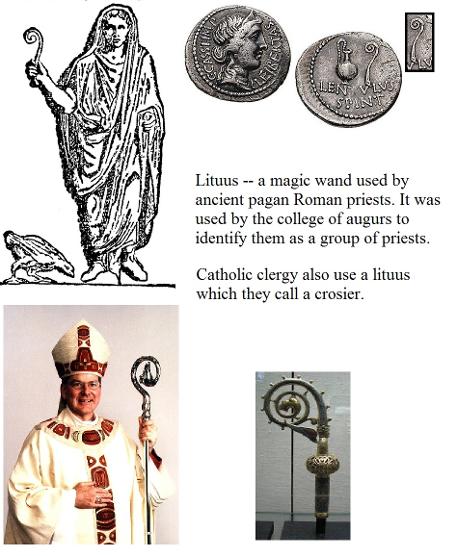
1. The CROSIER or LITUUS
From The Two Babylons, by Alexander Hislop, (p. 172) we get this description (bold / underline / color added):
But there is another symbol of the Pope's power which must not be overlooked, and that is the pontifical crosier. Whence [where from] came the crosier? The answer to this, in the first place, is, that the Pope stole it from the Roman augur[sorcerer / wizard]. [...] when the Roman augurs consulted the heavens, [...] ,there was a certain instrument [...] [with which] they should be equipped. That instrument [...] was curved at the one end, and was called "lituus." Now, so manifestly was the "lituus," or crooked rod of the Roman augurs, identical with the pontifical crosier, that Roman Catholic writers themselves, writing in the Dark Ages, at a time when disguise was thought unnecessary, did not hesitate to use the term "lituus" as a synonym for the crosier.
["Now, so manifestly was the "lituus," [...] identical with the pontifical [Pope's] crosier, that Roman Catholic writers themselves, [... ] [used] the term "lituus" as a synonym for the crosier."]
Thus a Papal writer describes a certain Pope or Papal bishop as "mitra lituoque decorus," adorned with the mitre and the augur's rod, meaning thereby that he was "adorned with the mitre and the crosier." But this lituus, or divining-rod, of the Roman augurs, was, as is well known, borrowed from the Etruscans, who, again, had derived it, along with their religion, from the Assyrians. As the Roman augur was distinguished by his crooked rod, so the Chaldean soothsayers and priests, in the performance of their magic rites, were generally equipped with a crook or crosier.
[THE LITUUS (CROSIER) ORIGINATED FROM NIMROD, FOUNDER OF BABYLON]
This magic crook can be traced up directly to the first king of Babylon, that is, Nimrod, who, as stated by Berosus, was the first that bore the title of a Shepherd-king. [...] Certain it is that Nimrod's deified successors have generally been represented with the crook or crosier. This was the case in Babylon and Nineveh, as the extant monuments show. In Layard, it may be seen in a more ornate form, and nearly resembling the papal crosier as borne at this day. * This was the case in Egypt, after the Babylonian power was established there, as the statues of Osiris with his crosier bear witness, ** Osiris himself being frequently represented as a crosier with an eye above it.
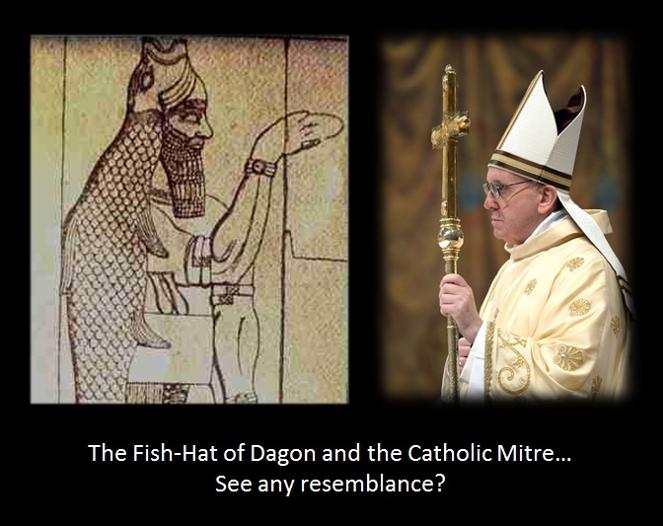
2. THE FISH HAT of DAGON and the
POPE'S MITRE
THE TWO-HORNED MITRE of the POPE is IDENTICAL to the MITRE worn by DAGON (the god of the Philistines).
Alexander Hislop, a historian, writes (The Two Babylons, pp. 171-172) (bold / underline added):
The excavations of Nineveh have put this beyond all possibility of doubt. The Papal mitre is entirely different from the mitre of Aaron and the Jewish high priests. That mitre was a turban. The two-horned mitre, which the Pope wears, when he sits on the high altar at Rome and receives the adoration of the Cardinals, is the very mitre worn by Dagon, the fish-god of the Philistines and Babylonians. There were two ways in which Dagon was anciently represented. The one was when he was depicted as half-man half-fish; the upper part being entirely human, the under part ending in the tail of a fish. The other was, when, to use the words of Layard, "the head of the fish formed a mitre above that of the man, while its scaly, fan-like tail fell as a cloak behind, leaving the human limbs and feet exposed.
Alexander Hislop (cont.):
Of Dagon in this form Layard gives a representation in his last work; and no one who examines his mitre, and compares it with the Pope's as given in Elliot's Horoe, can doubt for a moment that from that, and no other source, has the pontifical mitre been derived. The gaping jaws of the fish surmounting the head of the man at Nineveh are the unmistakable counterpart of the horns of the Pope's mitre at Rome. Thus was it in the East, at least five hundred years before the Christian era. The same seems to have been the case also in Egypt; for Wilkinson, speaking of a fish of the species of Siluris, says "that one of the Genii of the Egyptian Pantheon appears under a human form, with the head of this fish." In the West, at a later period, we have evidence that the Pagans had detached the fish-head mitre from the body of the fish, and used that mitre alone to adorn the head of the great Mediatorial god; for on several Maltese Pagan coins that god, with the well-known attributes of Osiris, is represented with nothing of the fish save the mitre on his head; very nearly in the same form as the mitre of the Pope, or of a Papal bishop at this day.
[Also, Cybele, the mystery goddess of Asia Minor and Syria , wore a two-horned mitre before the Roman Catholic Church was established.]
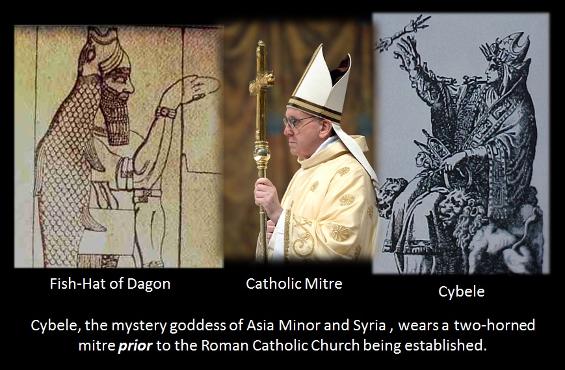
Even in China, the same practice of wearing the fish-head mitre had evidently once prevailed; for the very counterpart of the Papal mitre, as worn by the Chinese Emperor, has subsisted to modern times. "Is it known," asks a well-read author of the present day, in a private communication to me, "that the Emperor of China, in all ages, even to the present year, as high priest of the nation, once a year prays for and blesses the whole nation, having his priestly robes on and his mitre on his head, the same, the very same, as that worn by the Roman Pontiff for near 1200 years? Such is the fact." The reader must bear in mind, that even in Japan, still farther distant from Babel than China itself, one of the divinities is represented with the same symbol of might as prevailed in Assyria--even the bull's horns, and is called "The ox-headed Prince of Heaven." If the symbol of Nimrod, as Kronos, "The Horned one," is thus found in Japan, it cannot be surprising that the symbol of Dagon should be found in China.
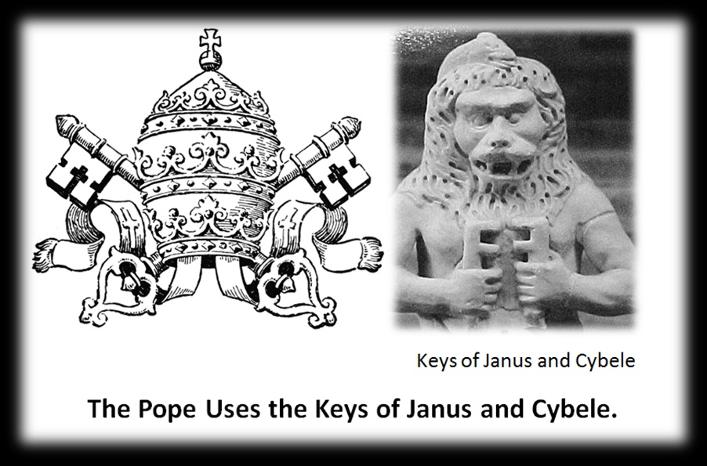
3. The Keys of Janus and Cybele and
the Pope's Keys
Alexander Hislop (author of The Two Babylons) writes that the Pope (a.k.a. the Bishop of Rome) did not claim to have "the Keys of St. Peter" until his authority was challenged. The papal "Keys of St. Peter" only came into existence after the Roman Empire split into the East and West Roman Empires: Constantinople being the capital of the East.
These keys had a pagan origin that the Pope drew his power from. Hislop writes (in The Two Babylons, p. 166-167) (bold / color / underline added):
The Pope needed to get both the Christians and the Pagans under his power. He did this by claiming to hold the keys of Janus and Cybele (pagan gods). If the Pope could get the Christians to believe that he only held the keys Jesus Christ promised to every Christian (not just Simon Peter), the Pope would have ignorant Christians under his power too. Ironically, the keys the Pope bore were the keys of a "Peter" from paganism.
[...] for the first three centuries, their [the Popes'] claim for superior honour was founded simply on the dignity of their see,[...] the capital of the Roman world. When, however, the seat of empire was removed to the East, and Constantinople threatened to eclipse Rome, some new ground for maintaining the dignity of the Bishop of Rome must be sought. That new ground was found, when, about 378, the Pope fell heir to the keys that were the symbols of two well-known Pagan divinities at Rome.
[The Pope Uses the Keys of Janus and Cybele]
Janus bore a key, and Cybele bore a key; and these are the two keys that the Pope emblazons on his arms as the ensigns of his spiritual authority. How the Pope came to be regarded as wielding the power of these keys [...] at the period referred to is certain.
The keys that the Pope bore were the keys of a "Peter" well known to the Pagans initiated in the Chaldean Mysteries. That Peter the apostle was ever Bishop of Rome has been proved again and again to be an arrant [in error] fable. That he ever even set foot in Rome is at the best highly doubtful. [...]
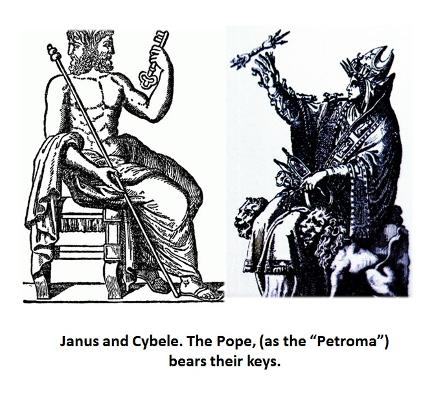
[In Pagan Rome, the High Priest of Paganism was called "Peter", "the interpreter".]
[...] it can be shown to be by no means doubtful that before the Christian era, and downwards, there was a "Peter" at Rome, who occupied the highest place in the Pagan priesthood. The priest who explained the Mysteries to the initiated was sometimes called by a Greek term, the Hierophant; but in primitive Chaldee, the real language of the Mysteries, his title, as pronounced without the points, was "Peter"--i.e., "the interpreter."
As the revealer of that which was hidden, nothing was more natural than that, while opening up the esoteric doctrine of the Mysteries, he should be decorated with the keys of the two divinities whose mysteries he unfolded. *
* The Turkish Mufties, or "interpreters" of the Koran, derive that name from the very same verb as that from which comes Miftah, a key.
Thus we may see how the keys of Janus and Cybele would come to be known as the keys of Peter, the "interpreter" of the Mysteries. Yea, we have the strongest evidence that, in countries far removed from one another, and far distant from Rome, these keys were known by initiated Pagans not merely as the "keys of Peter," but as the keys of a Peter identified with Rome.
[The Book Petroma", or the "Book of the Grand Interpreter"]
In the Eleusinian Mysteries at Athens, when the candidates for initiation were instructed in the secret doctrine of Paganism, the explanation of that doctrine was read to them out of a book called by ordinary writers the "Book Petroma"; that is, as we are told, a book formed of stone. But this is evidently just a play upon words, according to the usual spirit of Paganism, intended to amuse the vulgar [or common people]. The nature of the case, and the history of the Mysteries, alike show that this book could be none other than the "Book Pet-Roma"; that is, the "Book of the Grand Interpreter," in other words, of Hermes Trismegistus, the great "Interpreter of the Gods." In Egypt, from which Athens derived its religion, the books of Hermes were regarded as the divine fountain of all true knowledge of the Mysteries. * In Egypt, therefore, Hermes was looked up to in this very character of Grand Interpreter, or "Peter-Roma." ** In Athens, Hermes, as its well known, occupied precisely the same place, *** and, of course, in the sacred language, must have been known by the same title. *
[...]
The priest, therefore, that in the name of Hermes explained the Mysteries, must have been decked not only with the keys of Peter, but with the keys of "Peter-Roma." [...] But the book of "Peter-Roma" accounts for what otherwise is entirely inexplicable. [...]
When the Pope came, [...] into intimate connection with the Pagan priesthood; [...] [and they came] under his control, what more natural than to seek not only to reconcile Paganism and Christianity, but to make it appear that the Pagan "Peter-Roma," with his keys, meant "Peter of Rome," and that that "Peter of Rome" was the very apostle to whom the Lord Jesus Christ gave the "keys of the kingdom of heaven"?
[In other words: Once the pagan priesthood of Rome was happy with the idea of "Peter-Roma" (the "Grand Interpreter") being the Pope and once ignorant Christians were happy with the explanation the Pope gave them, Catholicism could have both "Christians" and practicing pagans under its umbrella.]
The Bible does not teach the Simon Peter is the first Pope. The Bible says in Matthew:Hence, from the mere jingle of words, persons and things essentially different were confounded [or confused]; and Paganism and Christianity jumbled together, [...] [And,] to the blinded Christians of the apostacy, the Pope was the representative of Peter the apostle, while to the initiated pagans, he was only the representative of Peter, the interpreter of their well known Mysteries. Thus was the Pope the express counterpart of "Janus, the double-faced."
_______________________________________________
Matthew 16:15-1815 He saith unto them, But whom say ye that I am?16 And Simon Peter answered and said, Thou art the Christ, the Son of the living God.17 And Jesus answered and said unto him, Blessed art thou, Simon Barjona: for flesh and blood hath not revealed it unto thee, but my Father which is in heaven.18 And I say also unto thee, That thou art Peter, and upon this rock I will build my church; and the gates of hell shall not prevail against it.
Ephesians 2:19-20 (bold added)19 Now therefore ye are no more strangers and foreigners, but fellowcitizens with the saints, and of the household of God;20 And are built upon the foundation of the apostles and prophets, Jesus Christ himself being the chief corner stone;
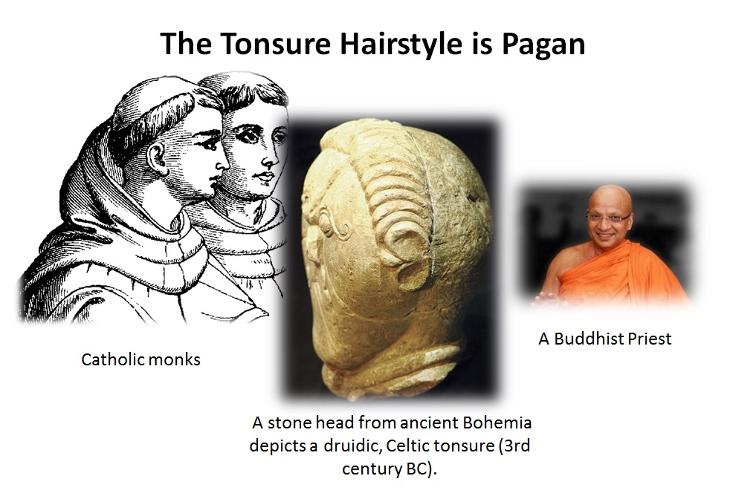
[A stone head from ancient Bohemia depicts a druidic, Celtic tonsure (3rd century BC).]
God forbids the practice of making a tonsure.
Leviticus 21:5 says, "They shall not make baldness upon their head, neither shall they shave off the corner of their beard, nor make any cuttings in their flesh."
4. The Origin of the Tonsure
Haircut of the Catholic Monks and
Clergy
Catholic monks are known to shave their heads in a circle at the top and on the sides, forming a style called a tonsure. This was not something invented by the Catholic religion. It started long before that.
Alexander Hislop writes (see The Two Babylons, pp. 175-176) (bold / underline / color added):
Now, as Rome set so much importance on this tonsure, let it be asked what was the meaning of it? It was the visible inauguration of those who submitted to it as the priests of Bacchus. This tonsure cannot have the slightest pretence to Christian authority. It was indeed the "tonsure of Peter," but not of the Peter of Galilee [of the Bible], but of the Chaldean "Peter" of the Mysteries. He was a tonsured priest, for so was the god whose Mysteries he revealed. Centuries before the Christian era, thus spoke Herodotus of the Babylonian tonsure: "The Arabians acknowledge no other gods than Bacchus and Urania [i.e., the Queen of Heaven], and they say that their hair was cut in the same manner as Bacchus' is cut; now, they cut it in a circular form, shaving it around the temples."
[The Mutilated "Prince" of Mystery Religion]
What, then, could have led to this tonsure of Bacchus? Everything in his [Bacchus's] history was mystically or hieroglyphically represented, [...] [and] none but the initiated could understand. One of the things that occupied the most important place in the Mysteries was the mutilation to which he [Bacchus] was subjected when he was put to death.
[Note: For more information about Bacchus's (or Nimrod's) death, CLICK HERE and go to page 60. You can start reading here: "Now when Shem had so powerfully..."]
In memory of that, he was lamented with bitter weeping every year, as "Rosh-Gheza," "the mutilated Prince." But "Rosh-Gheza" also signified the "clipped or shaved head." Therefore he was himself represented either with the one or the other form of tonsure; and his priests, for the same reason, at their ordination had their heads either clipped or shaven.
Over all the world, where the traces of the Chaldean system are found, this tonsure or shaving of the head is always found along with it. The priests of Osiris, the Egyptian Bacchus, were always distinguished by the shaving of their heads. In Pagan Rome, in India, and even in China, the distinguishing mark of the Babylonian priesthood was the shaven head.
[Gautama Buddha shaved his head]
Thus Gautama Buddha, who lived at least 540 years before Christ, when setting up the sect of Buddhism in India which spread to the remotest regions of the East, first shaved his own head, in obedience, as he pretended, to a Divine command, and then set to work to get others to imitate his example. One of the very titles by which he was called was that of the "Shaved-head." "The shaved-head," says one of the Purans, "that he might perform the orders of Vishnu, formed a number of disciples, and of shaved-heads like himself."
The high antiquity [of ancient times] of this tonsure may be seen [...] in the Mosaic law against it. The Jewish priests were expressly forbidden to make any baldness upon their heads (Lev 21:5), which sufficiently shows that, even so early as the time of Moses, the "shaved-head" had been already introduced. In the Church of Rome the heads of the ordinary priests are only clipped, the heads of the monks or regular clergy are shaven, but both alike, at their consecration, receive the circular tonsure, thereby identifying them, beyond all possibility of doubt, with Bacchus, "the mutilated Prince." *
